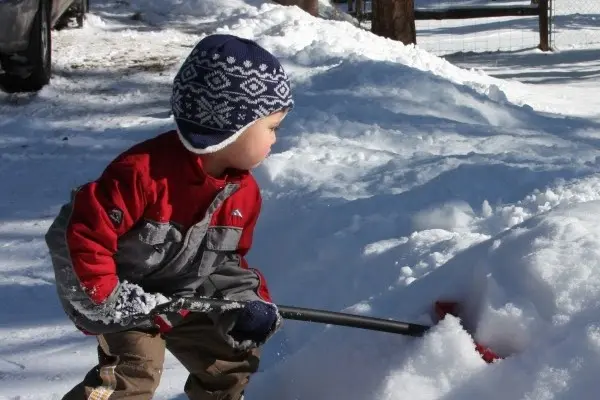Resources for Residents
Salt Smart at Home

Throughout much of the country, rock salt is used to maintain safe driving conditions during and after winter storms. As snow and ice are melted, the dissolved salt is carried in the melt water to local streams and lakes or is infiltrated into the groundwater. The salt can also remain on the landscape or in detention basins and storm sewers long after the winter, providing a constant source of chlorides to our local waterways every time it rains well into the summer.
Here are some impacts road salt can have on our environment:
- At high concentrations, chloride is toxic to fish and insects.
- At lower levels, chloride can negatively affect the fish and insect populations by reducing reproduction and survival rates of young.
- Direct road salt splash can kill plants and grass.
- Sodium in road salt can destroy soil stability, decreasing the ability of the soil to filter water, and increasing soil erosion.
Best Practices for Snow and Ice
- Shovel (and use the right tool for the job). The more snow and ice you remove manually, the less salt you will have to use and the more effective it will be when you do use it.
- 15˚F is too cold for salt. Most salts stop working at this temperature. Use sand instead for traction, but remember that sand does not melt ice.
- For best results, apply salt to cleared surfaces. The salt crystals should not overlap but be spread out a few inches apart.
- More salt does not mean more melting. Use less than 4 pounds of salt per 1,000 square feet (an average parking spot is about 150 square feet). One pound of salt is approximately a heaping 12-ounce coffee mug.
- Sweep up extra. If salt or sand is visible on dry pavement it is no longer doing any work and will be washed away into your local streams through a storm drain or ditch system.
- Even if the de-icer says it's safe for pets - look at the ingredients! Calcium and magnesium chloride can burn their paws. Use a product with glycol or just use sand. And when you take your animals on a walk, cover their feet and/or wash them off after a walk. (And remember to pick up their poop!)
Road Salt FAQs

What is road salt made of?
Road salt is technically halite, which is simply the mineral form of sodium chloride, or salt. It's just a less pure version of table salt.
What is the best salt for driveways?
Any salt should be perfectly fine for driveway use. However, if you're worried about exceptionally cold temperatures or potential damage to your driveway, magnesium chloride or calcium chloride road salts are gentler choices.
How is road salt different from table salt?
Road salt is just a non-purified version of regular salt, with more minerals in the mix.
Why do we use road salt?
Salt actually lowers the freezing temperature of the water. Instead of freezing at 32 degrees Fahrenheit (0 degrees Celsius), salt brings the freezing temperature down to around 0 degrees F (minus 18 degrees C).
What can I use instead of road salt?
You can swap out road salt for sand, which increases traction and prevents more ice from forming on surfaces. You can also use some unique foods — beet juice mixed with salt brine and even pickle juice have been shown to lower the freezing temperature of roads notes, according to IWLA.org.
Additional Salt Smart Tips
Pool Draining Tips to Protect Local Waterways
Improper disposal of pool water can harm our environment and is considered an illegal discharge under local stormwater regulations.
Draining pool water into storm drains may seem harmless, but it can have serious environmental consequences. Pool water often contains chlorine, salts, algaecides, and other chemicals that are toxic to aquatic life. When discharged improperly, these pollutants can harm fish and other wildlife, disrupt ecosystems, and degrade water quality.
Follow These Steps for Safe Pool Draining:
-
Stop adding chlorine or other chemicals at least 10 days before draining.
This allows the water to become dechlorinated naturally. Test the water to make sure chlorine levels are undetectable before proceeding. -
Drain onto your lawn or landscaped areas.
Select a location that can absorb water slowly. -
Never drain water directly into the street or storm drains.
These flows directly impact our creeks, potentially harming wildlife and violating City ordinances.
Salt Smart Water Softening
Wastewater treatment plants are not able to remove salt from wastewater, so every bag of salt that goes into your water softener passes through the treatment plant and into a local lake or stream. If you are on a private septic system, softener salt is infiltrating into groundwater. Increasing your water softener's efficiency helps protect our freshwater resources.
How Water Softening Works
In Boone County, most groundwater is classified as hard water, meaning it has a high concentration of minerals such as calcium and magnesium. Hard water can lead to lime scale buildup, potentially damaging water heaters and drying out hair and skin. As a result, many residents choose to use water softeners to address these issues.
Water softeners operate through a process called ion exchange. Essentially, they replace calcium and magnesium ions—elements that contribute to hard water—with sodium ions. Here's how it works: hard water flows through resin beads that are charged with sodium ions. As the water passes through these beads, the calcium and magnesium are exchanged for sodium, effectively softening the water.
Reducing Water Softeners' Impact
Fortunately, there are ways to reduce the amount of salt used by water softeners.
-
Higher Salt-Efficiency Systems
Salt-efficient water softeners require less salt to soften the same volume of water compared to less efficient systems. Some softeners can be customized to meet your household's specific needs, which often involves optimizing the regeneration process—the brine wash phase. By fine-tuning when regeneration occurs, you can significantly reduce the amount of sodium and chloride that is discharged into the drain. -
Saltless Water Conditioners
Saltless water conditioners do not use sodium chloride at all. Instead of removing minerals from hard water, they alter the charge of minerals to prevent build-up on plumbing and water heaters. Typically, they use an electric charge to accomplish this. Because these systems don’t remove calcium and magnesium, there is no need to use brine to regenerate the system. If damage to your plumbing is your primary concern, a saltless water conditioner may be the solution you need.